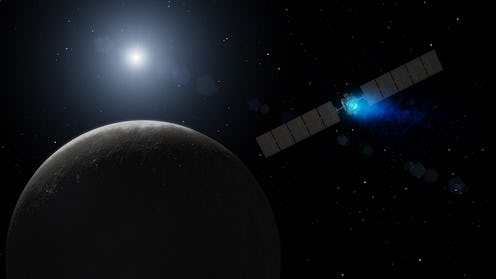News
NASA's Dawn Spacecraft Took Some Amazing Photos

The universe is a big place. It's so big, in fact, that physicists are still at odds over whether it's actually infinite, or whether it's just unfathomably extensive, so much so that humans simply can't comprehend its scale. Thanks to NASA, we're beginning to comprehend at least one little corner of it. On Monday, the 65-foot long Dawn spacecraft sent back new images of dwarf planet Ceres, the next destination on its long journey through the asteroid belt between Mars and Jupiter. The probe is slated to reach the planet's orbit on Friday, at which time scientists hope to receive even more.
As it happens, the latest batch of images may have left astronomers more (pleasantly) puzzled than ever: after the Dawn probe first sent back relatively distant photos of the dwarf planet back in January, mission scientists were perplexed by two strange, glimmering white spots that seemed to bounce light back from their respective surfaces. This time around, the mystery of the bright spots has grown stranger. After analyzing the photos, researchers proposed that the reflective spots may actually be part of a vast sub-surface ice layer that was exposed after a meteor impact.
"As Dawn has come closer to Ceres, the bright spots have become brighter and smaller," said Chris Russell, principal investigator of the Dawn mission at UCLA in a statement on Feb. 27. "Indeed, they are much brighter than the surrounding landscape and still unresolved in our images. The point of origin must be very small."
The bright white spots aren't the only thing mission scientists found upon examination of the new photos. As the probe nears the tiny planet Ceres, which is only about one-fifth the size of the continental United States, it has been able to capture images of the rocky surface layer, which is riddled with impact craters and elevated plateaus, much like the planet Mercury and Earth's own moon (unsurprising for a planetary body in its region). By studying Ceres' makeup, scientists are better able to determine the origins of local planets in our solar system and expand upon our current knowledge of how these celestial bodies are formed. In a statement to NASA's Jet Propulsion Laboratory in Pasadena, California, Carol Raymond, deputy project scientist, said:
Both Vesta [a nearby protoplanet] and Ceres were on their way to becoming planets, but their development was interrupted by the gravity of Jupiter. These two bodies are like fossils from the dawn of the solar system, and they shed light on its origins.
By studying Vesta and Ceres, we will gain a better understanding of the formation of our solar system, especially the terrestrial planets and most importantly the Earth. These bodies are samples of the building blocks that have formed Venus, Earth and Mars. Vesta-like bodies are believed to have contributed heavily to the core of our planet, and Ceres-like bodies may have provided our water.
Since its initial contact in December 2014, Dawn's cameras have been able to finally capture Ceres' full nine-hour rotation on camera for the first time as well. The dwarf planet may not be large, but it's nonetheless spectacular, and by December of this year, scientists hope to photograph the planet at less than 250 miles above its surface, following a nine month controlled orbit spiral.
Named after the Roman goddess of agriculture and harvests, the rocky outlier has already provided a host of amazing discoveries — and the researchers behind the mission are eager to find out what else the tiny planet has in store for them, whether it's a wealth of information critical to our knowledge of the earth, or even the potential to support life, should Dawn discover water beneath its surface. According to The Washington Post, when asked in a news conference on Monday about the first hurdle to unlocking Ceres' secrets (its gleaming white spots), Raymond added:
The team is really, really excited about this feature, because it is unique in the solar system. The mystery will be solved, but it's one that's really got us on the edge of our seats.
Images: NASA/JPL-Caltech/UCLA/MPS/DLR/IDA (2)